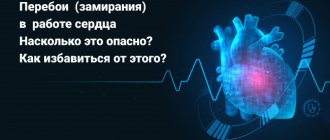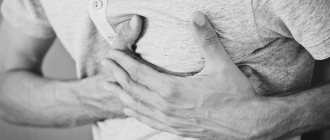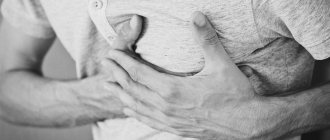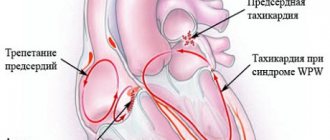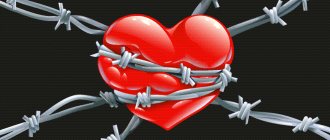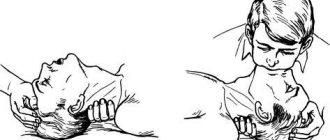What causes angina attacks?
Being a frequent companion of coronary artery disease, angina pectoris attacks occur as a result of hypoxia of cardiac muscle tissue. This is due to impaired patency of the coronary arteries; they are responsible for supplying the heart with arterial oxygenated blood. Atherosclerosis of the heart vessels leads to coronary artery disease, a process that results in the appearance of cholesterol plaques on the vascular walls. They are the ones who impede blood flow in this area. Fragments of atheromatous deposits can separate, leading to blockage of blood vessels. More information about what causes angina pectoris can be found here.
In what cases is Nitroglycerin contraindicated during an attack of angina?
The patient or his relatives should be aware that if signs of low blood pressure are detected (with collaptoid angina), taking drugs from the group of organic nitrates (Nitroglycerin, Isoket, etc.) is contraindicated. The following signs may indicate hypotension:
- the patient experiences severe weakness;
- dizziness;
- pallor;
- cold sweat.
In such cases, the sequence of actions should be as follows:
- Lay the patient down.
- Call an ambulance.
- Give him a crushed Aspirin tablet.
- To reduce pain, you can use tablet analgesics (Baralgin, Sedalgin, etc.).
How to recognize an angina attack?
Symptoms of an angina attack may vary slightly depending on the stage of the disease and the characteristics of its course. Characteristic symptoms of angina pectoris are:
- pain of a burning or pressing nature, which can be felt in the area of the heart or shoulder blade, behind the sternum, radiating to the shoulder or neck;
- severe shortness of breath;
- nausea;
- weakness;
- dizziness;
- high blood pressure;
- feeling of anxiety, fear.
Such sensations are the first sign that you should see a doctor and undergo a cardiological examination. Some people with angina do not feel obvious pain, complaining only of minor discomfort.
How to relieve an attack at home?
First of all, it is necessary to provide the patient with peace. The optimal position is considered to be a semi-sitting position with support under the head and back; it is advisable to create access to fresh air. It is necessary to loosen clothing in the neck and waist area in order to facilitate breathing movements. During an attack, you must avoid drinking any liquids and food, as well as smoking. It is important to constantly reassure the patient, because any emotional stress can lead to a deterioration of the condition and even to a hypotonic crisis and collapse. It is imperative to monitor the patient’s vital functions (heartbeat and breathing) and be prepared, if necessary, to immediately begin cardiopulmonary resuscitation.
If the condition does not improve after 15 minutes of rest and/or taking Nitroglycerin, it is highly likely that the patient will develop a myocardial infarction . In this case, it is necessary to take acetylsalicylic acid (provided there is no allergic reaction to it) in the form of a chewable tablet, note the time and immediately call emergency medical help.
Emergency medical care is also required under the following conditions:
- chest pain appeared for the first time;
- the symptoms of angina pectoris differ in strength from those during previous attacks;
- the nature of the pain has changed.
You should never transport a patient with chest pain in your car, since any overexertion can worsen the patient’s condition and it will be extremely difficult to correct it in such conditions.
Conditions for an attack
Typically, angina attacks in coronary artery disease begin with emotional or physical stress (angina pectoris). With a stable course of IHD, they last no more than 10 minutes and quickly pass after taking medications that relieve pain. Depending on the intensity of the load that causes the attack, functional classes of angina pectoris are distinguished. Sometimes pain can appear for no reason, sometimes during rest or sleep - this is angina at rest. This manifestation of IHD is very dangerous due to its unpredictability: attacks are more difficult to stop, and the pain can be more intense and longer lasting. Angina at rest is classified as an unstable form of angina.
Emergency care for angina pectoris: algorithm of actions
If the attack was caused by overexertion, then with PMP the patient needs rest. Stop the movement and take a comfortable position. Standing up and walking is prohibited, as this can provoke fear and increased pain.
Rest is necessary, take a comfortable position.
You need to immediately count your pulse and track your breathing. The victim needs fresh air. He is freed from restrictive clothing and the temperature is stabilized. For those who have frequent attacks, the first first aid for angina pectoris will be a first aid kit with special medications - nitroglycerin, acetylsalicylic acid and Corvalol.
- Symptoms of an angina attack, how to relieve it at home, what needs to be examined and how to treat it
To help, give a capsule or tablet of nitroglycerin.
How does cupping happen? A capsule or tablet of nitroglycerin is dissolved under the tongue, which dilates blood vessels and stabilizes the heartbeat. It is permissible to use Nitromint aerosol in one dose. To quickly thin the blood, chew an aspirin tablet in a dose of at least 60 mg.
Psychological stress can be relieved with tincture of motherwort, valerian or corvalol. If there is a sharp rise in blood pressure, a special antihypertensive drug, which was prescribed by the attending physician, comes to the rescue. After eliminating the attack, the patient is advised to rest in bed and distribute physical and emotional stress in such a way as to avoid relapse.
Prolonged attack
First aid for a persistent attack of angina is carried out in a hospital setting. An ECG is performed to determine the functioning of the heart. Oxygen therapy will help make breathing easier.
- For variant attacks, along with nitroglycerin, Corinfar is placed under the tongue in a dose of 10 mg. Corinfar is also used under the tongue.
- Intense symptoms, tachycardia and high blood pressure require the administration of adrenergic blockers. Be sure to take into account the patient’s condition and possible contraindications.
- If the symptom lasts for more than 10 minutes or there is no effect from nitroglycerin, chew aspirin at least 250 mg. The tablet should not have a shell. Talamonal is administered if pain persists even after taking nitroglycerin. The drug is replaced with Morphine or Promedol. If there is no effect from nitroglycerin, chew aspirin.
- In the absence of narcotic analgesics, slow intravenous administration of other drugs - Tramadol, Droperidol - is permissible.
- First aid for angina pectoris includes the administration of heparin by the jet method if the cardiogram shows ischemic disorders.
Angina attack: first aid
Relieving an attack of angina is a necessary first aid measure. It is important for both the patient suffering from angina and his loved ones to know its basic principles. First aid for an angina attack - simple measures that help save a person’s life. Pre-medical care is provided even before the patient gets an appointment with a doctor or cardiology clinic. This is a set of measures that should be taken to help a person who suspects he is having an angina attack.
- Usually unpleasant symptoms appear during physical activity. Therefore, the first thing the patient should do is stop moving, sit down or lie down.
- Another factor that causes attacks is lack of oxygen. That is why sometimes alarming signs appear when a person is in a stuffy room. It is necessary to provide the patient with a flow of air - open the window, unbutton the shirt.
- If you happen to provide first aid to a person who knows about his disease during an attack of angina, he will probably have with him a medicine prescribed by a doctor, nitroglycerin, which will help relieve symptoms and reduce pain. The drug is taken according to the regimen recommended by the cardiologist.
- If the attack occurs for the first time, then immediately after it stops you should consult a doctor for an examination: angina pectoris that occurs for the first time is unpredictable and therefore requires urgent diagnosis.
- If an attack lasts 15 minutes or more, and does not go away even after taking medications, the patient must be hospitalized immediately, as this may be a sign of a heart attack (heart attack). In this case, call 03 immediately!
Correctly provided first aid is no less important than timely diagnosis of angina and its treatment: the sooner measures are taken, the less chance that the attack will end tragically.
Treatment of angina pectoris is carried out as part of the treatment of coronary artery disease. Since the main cause of obstruction of the heart vessels is atherosclerosis, therapy in this case should be aimed at reducing the level of cholesterol in the blood and thinning it. Prevention of angina pectoris is also of great importance: normalizing lifestyle and avoiding factors that provoke the growth of cholesterol plaques in blood vessels. We will tell you more about the methods of treating angina pectoris in the next publication.
“Online registration for vaccination against Covid-19 infection”
Angina pectoris is a serious disease that should not be ignored. Properly provided emergency care for angina pectoris will help prevent the development of a heart attack.
Angina pectoris is a consequence of coronary heart disease. The reason for its development is coronary insufficiency, which occurs due to narrowing of the arterial lumen.
What are the causes of an angina attack?
To help the victim, you need to know how an angina attack manifests itself, as well as the reasons for its development. It usually develops during physical activity. Often the trigger is stressful situations. In this case, they talk about exertional angina.
There is another variant of an angina attack; it can occur even at rest. This usually happens during sleep or in the morning. This type of disease is called resting angina. The unpredictable development of an attack is the most dangerous.
The following factors can also provoke angina:
- increased blood pressure;
- consumption of energy drinks and alcohol;
- smoking;
- listening to loud music.
The frequency of attacks is influenced by the degree of reduction in the lumen of the coronary artery. With pronounced pathology, pain appears up to several times a day. With age, the number of ailments increases. If angina is diagnosed, emergency care is necessary.
Angina attacks can occur at different intervals. The most severe of them lead to necrosis in the heart muscle, namely myocardial infarction. Subsequently, a scar will remain in this place.
The disease is accompanied by pressing pain accompanied by burning sensations. The pain syndrome is localized in the sternum area. The pain is reflected in the neck, in the arm, and even moves to the jaw.
The attack is characterized by the following symptoms:
- pale skin;
- increased blood pressure;
- heart rhythm failure;
- dyspnea;
- nausea;
- perspiration;
- headache.
The duration of the illness on average is no more than five minutes, but there are longer options when the illness causes concern for more than 10 minutes. The attack may be short-lived and go away on its own.
Prolonged attacks of angina are the most dangerous; they are the cause of the development of cardiac complications, such as, for example, myocardial infarction. In order to avoid complications, it is important to provide the victim with adequate emergency care.
Emergency care for angina pectoris
Angina attacks require emergency care. The algorithm of actions for eliminating the symptoms of the disease includes the following procedures.
If the illness was provoked by physical activity, the patient must immediately stop moving, take a comfortable position, any exertion is prohibited, and he must not get up or walk. It is important to monitor your breathing; it should be even and deep.
In addition, the patient needs fresh air. You need to remove tight clothes from him and create a suitable temperature regime. First aid for angina pectoris includes taking medications, which should always be on hand for people suffering from heart disease.
To relieve an attack, the patient is given the following medications:
- Lay the sick person down with his head raised.
- Unfasten the belt, collar, loosen the tie, which will help relieve suffocation.
- Provide air access to the room.
- Chew an aspirin tablet 250-300 mg, take a nitroglycerin tablet 0.5 mg or as a spray under the tongue (if there is no effect, repeat twice after 5-7 minutes, under control of blood pressure and heart rate).
- If severe weakness appears, raise your legs to a level above your head, give them water to drink and no longer give nitroglycerin.
- Do not leave the patient until the doctor arrives.
- The doctor must show all medications taken.
- Call “103” immediately if the attack is not stopped.
An attack of angina can cause panic and anxiety. Close people urgently need to reassure the patient. You may need to take a sedative. These actions will help eliminate the ailment. After the attack has stopped, the patient should remain in bed. To prevent relapses, it is important to dose physical activity and avoid psycho-emotional stress.
Features of taking Nitroglycerin during an attack of angina
Nitroglycerin is the most effective remedy for relieving an attack of angina. But it should be taken with caution.
The action of Nitroglycerin should begin within a couple of minutes; if this does not happen, the dose can be repeated. But you should know that you should not take more than three tablets at a time.
Nitroglycerin is not always indicated for use. In some cases you cannot drink it. Contraindication is low blood pressure - hypotension.
Hypotension is accompanied by the following symptoms:
- general weakness;
- dizziness;
- paleness of the skin;
- cold sweat appears.
Taking Nitroglycerin for hypotension will worsen the patient's condition and reduce blood supply to the myocardium. It is advisable to measure your blood pressure before taking the medicine, if possible. In addition, this drug causes severe headaches. To relieve these effects, you will need to take painkillers.
Not every angina attack requires calling an ambulance. You will need to call a doctor in cases where:
- an attack of angina occurred for the first time;
- the discomfort did not go away after five to ten minutes;
- if the illness has become severe, symptoms appear that were not there before;
- it was not possible to eliminate the symptoms of the disease in the usual way;
- An unbearable growing pain appeared in my heart.
For angina pectoris, first aid plays a very important role.
Prevention
An active lifestyle is the main recipe for preventing all diseases. In addition to exercise, proper nutrition (more raw fruits and vegetables, low salt and carbohydrate intake), and quitting smoking and alcoholic beverages are necessary. After 40 years, regular monitoring of blood pressure, blood sugar and cholesterol levels is required. It is important to be in a positive mood in life and avoid stressful situations.
A primary attack of angina is an alarming sign that can signal possible heart disease. The patient needs to consult a cardiologist.
Cardiologist Sushko O.F.
Nursing process for angina pectoris
Patient's problems Present: - complaints of pain in the heart area (behind the sternum), compressive, occurring during physical activity and after excitement, and sometimes at rest. The pain is relieved by taking nitroglycerin (after 2-4 minutes), but after the attack there is a headache; - pain in the heart area is sometimes accompanied by short-term interruptions in the heart area; - shortness of breath on exertion. Physiological: - difficulties with defecation. Psychological: - the patient is very worried about the unexpectedness of his illness, which has disrupted his life plans and also reduced his quality of life. Priority: - shortness of breath on exertion. Potential: - pain in the heart area, which occurs at rest, indicates the progression of the disease, myocardial infarction may develop. Lack of knowledge: - about the causes of the disease; - about the prognosis of the disease; - the need to take prescribed treatment; — about risk factors; - about proper nutrition; - about self-care. Actions of the nurse Carrying out general care for the patient: - changing underwear and bed linen, feeding the patient according to the prescribed diet, ventilating the room (make sure there are no drafts); — fulfillment of all doctor’s prescriptions; — preparing the patient for diagnostic studies. Teaching the patient and his relatives how to properly take nitroglycerin during an attack of pain. Teaching the patient and his relatives to keep an observation diary Conducting conversations: - consolidate in the patient’s mind the fact that during an attack of angina, myocardial infarction can develop, and in the absence of careful attitude to one’s health, the attack can end in death; — convince the patient of the need to systematically take antianginal and lipid-lowering medications; - the need to change your diet; - about the need to constantly monitor your condition. Conversation with relatives regarding the need to follow a diet and monitor the timely intake of medications. Motivate the patient to change lifestyle (reduce risk factors). Counsel patient/family on prevention. Complications of angina: - acute myocardial infarction; — acute rhythm and conduction disturbances (up to SCD); - acute heart failure. Indications for hospitalization: - new-onset angina pectoris; - progressive angina pectoris; - angina pectoris that first appeared at rest; - spontaneous (vasospastic) angina. All patients with the above types of angina should be urgently hospitalized in specialized cardiology departments.
Principles of diagnosing ischemic heart disease
Diagnosis of angina pectoris during a painful attack The diagnosis of angina pectoris is often based on the following main signs: - the nature of the pain - compressive; - localization of pain - usually behind the sternum; - irradiation of pain - to the left shoulder girdle, to the lower jaw; - conditions of occurrence - physical stress, psycho-emotional arousal, exposure to cold; - the attack may be accompanied by tachycardia, moderate hypertension; - the temperature is normal; — clinical blood test is unchanged; - pain goes away after taking nitroglycerin or with rest. Primary assessment of the patient's condition The clinical diagnosis of angina is made on the basis of a detailed qualified survey of the patient, a thorough study of his complaints and a careful study of the anamnesis. All other research methods are used to confirm or exclude the diagnosis and clarify the severity of the disease - prognosis. Although in many cases the diagnosis can be made based on complaints, it should be borne in mind that the patient does not always accurately describe his feelings. Therefore, recently attempts have been made to create a so-called standardized questionnaire for patients suffering from angina (of course, its full use is possible in the interictal period). During the initial examination, before obtaining the results of an objective examination, it is necessary to carefully evaluate the patient’s complaints. Pain in the chest can be classified depending on the location, provoking and relieving factors: typical angina, probable (atypical) angina, cardialgia (non-coronary chest pain). With atypical angina, of the three main characteristics (all signs of pain, connection with physical activity, pain-relieving factors), two of them are present. With non-coronary chest pain, only one of the three characteristics occurs or they are absent altogether. For a correct diagnosis, the patient's habitus is important. When examining a patient during an attack of angina, a frightened facial expression, dilated pupils, perspiration on the forehead, somewhat rapid breathing, pale skin. The patient is restless and cannot lie still. There is an increase in heart rate and often an increase in blood pressure, and various heart rhythm disturbances are possible. In many patients, hypertension may have existed before the onset of angina, and an additional increase in blood pressure can only increase clinical symptoms. On auscultation, as a rule, tachycardia (rarely bradycardia) and muffled tones are noted.
Additional research methods for ischemic heart disease
Laboratory tests: - clinical blood test; - biochemical blood test: determination of total cholesterol, HDL cholesterol, LDL cholesterol, triglycerides, hemoglobin, glucose, AST, ALT in the blood. Instrumental diagnosis of myocardial ischemia: - recording ECG at rest; — ECG registration during an attack; — stress ECG tests (VEM, treadmill test); — EchoCG and stress echocardiography; — Holter 24-hour ECG monitoring (with MECG); — myocardial scintigraphy; — MRI; — KAG. Differential diagnosis with Cardiac neurosis Osteochondrosis Diaphragmatic hernia High gastric ulcer Angina pectoris must also be differentiated from syphilitic aortitis. Pain in the chest also occurs with other diseases, which should be remembered in case of atypical variants of coronary artery disease. Cardiovascular: - dissecting aortic aneurysm; - pericarditis; - pulmonary embolism. Pulmonary: - pleurisy; - pneumothorax; - lung cancer. Gastrointestinal: - esophagitis; - spasm of the esophagus; - reflux esophagitis; - intestinal colic. — Psychoneurological: — state of anxiety; - the heat of passion. Associated with the chest: - fibrositis; - injuries to the ribs and sternum; - intercostal neuralgia; - herpes zoster (before the rash stage). A separate category is reflex angina, which occurs due to pathology of nearby organs: peptic ulcer, cholecystitis, renal colic, etc. Prognosis of the course of coronary artery disease The quality and life expectancy of a patient with angina depends on: - early detection of the disease; — compliance with the regimen of taking prescribed medications; — lifestyle changes and elimination of risk factors. In other words, if you make certain changes in your lifestyle and take recommended medications, you can continue to live a full life. The main conditions for this are an understanding of the essence of the condition and the patient’s willingness to cooperate with medical personnel. Treatment and treatment goals : - improve the prognosis and prevent the occurrence of myocardial infarction or SCD and accordingly increase life expectancy; - reduce the frequency and intensity of angina attacks in order to improve the quality of life. The choice of treatment method depends on the response to initial drug therapy, although some patients immediately prefer and insist on surgical treatment - TKA, CABG. In the selection process, the patient’s opinion is taken into account, as well as the ratio of price and effectiveness of the proposed treatment. Non-drug treatment of angina pectoris includes: lifestyle changes and counteracting risk factors for coronary artery disease. Drug treatment of angina pectoris 1. Antianginal (anti-ischemic) therapy This treatment is prescribed to patients with attacks of angina or when diagnosing episodes of myocardial ischemia using instrumental methods. Antianginal drugs include: - beta blockers; - calcium antagonists; - nitrates; - nitrate-like drugs; — myocardial cytoprotectors. It is recommended that these classes of drugs be prescribed in this order for the treatment of stable angina, and that they be used in various combinations. Drugs that are not recommended to be prescribed to patients for the treatment of angina pectoris: vitamins and antioxidants, female sex hormones, riboxin, adenosine triphosphate (ATP), cocarboxylase. 2. Medicines that improve the prognosis in patients with angina pectoris. They are recommended for all patients diagnosed with angina pectoris in the absence of contraindications. Antiplatelet drugs, more correctly called antiplatelet agents (acetylsalicylic acid - ASA, clopidogrel) are mandatory treatments for stable angina. All patients after myocardial infarction are recommended to be prescribed a BB without internal sympathomimetic activity: metoprolol, bisoprolol, propranolol, atenolol. Lipid-lowering drugs Beta-blockers (selective action) - Metoprolol (betaloc ZOK, Corvitol, Egilok, Emzok) 50-200 mg 2 times a day. — Atenolol (atenolan, tenormin) 50-200 mg 1-2 times a day. — Bisoprolol (bisogamma, concor, concor cor) 10 mg/day. — Betaxolol (betak) 10-20 mg/day. — Pindolol (Wisken) 2.5-7.5 mg 3 times a day. — Nebivolol (nebilet) 2.5-5 mg/day. - Carvedilol (acridilol, Dilatrend, Cardivas) - 25-50 mg 2 times a day. Calcium antagonists 1. Dihydropyridine - Nifedipine - moderately prolonged (adalat SL, cordaflex retard, corinfar retard) 30-100 mg/day; significantly prolonged (osmo-adalat, cordipin CL, nifecard CL) 30-120 mg/day. — Amlodipine (norvasc, cardlopin, normodipine, kalchek, amlovas, vero-amlodipine) 5-10 mg/day. — Felodipine 5-10 mg/day. — Isradipine 2.5-10 mg 2 times a day. — Lacidipine 2-4 mg/day. 2. Non-dihydropyridine - Diltiazem (diltiazem-Teva, diltiazem Lannacher) 120-320 mg/day. - Verapamil (isoptin, lecoptine, finoptin) - 120-480 mg/day. Nitrates and nitrate-like drugs 1. Nitroglycerin preparations - Short-acting (nitromint, nitrocor, nitrospray) 0.3-1.5 mg sublingually for angina pectoris. — Long-acting (nitrong forte) 6.5-13 mg 2-4 times a day. 2. Preparations of isosorbide dinitrate - Long-term action (cardiquet 40, carditet 60, carditet 120, iso Mac retard) 40-120 mg/day. — Moderate duration of action (isolong, cardiket 20, iso Mak 20, nitrosorbide) 20-80 mg/day. 3. Preparations of isosorbide mononitrate - Moderate action (monosan, monocinque) 40-120 mg/day. - Long-acting (olicard retard, monocinque retard, pectrol, efox long) 40-240 mg/day. 4. Molsidomine preparations - Short-acting (Corvaton, Sidnopharm) 4-12 mg/day. — Moderate duration of action (dilasid) 2-4 mg 2-3 times a day. — Long-acting (dilasidom retard) 8 mg 1-2 times a day. Surgical treatment of coronary artery disease The main indication for surgical treatment of coronary artery disease is the persistence of severe angina (FC III-IV), despite intensive drug treatment. The indications and nature of surgical treatment are specified based on the results of coronary angiography and depend on the degree, prevalence and characteristics of coronary artery lesions. Patients with frequent attacks of angina pectoris and insufficient drug therapy or those with multiple risk factors, including a family history of sudden death, should undergo angiographic examination of the coronary arteries. If narrowing of the main left trunk of the coronary artery and changes in 3 coronary arteries are detected, myocardial revascularization is indicated. Myocardial revascularization includes - Various types of TKA (transcutaneous angioplasty) with the installation of a metal frame - an endoprosthesis (stent), burning out the plaque with a laser, destroying the plaque with a rapidly rotating drill and cutting off the plaque with a special atherotomy catheter. — CABG surgery to create an anastomosis between the aorta and the coronary artery below the site of narrowing to restore effective blood supply to the myocardium. Currently, there is a definite tendency to bypass the maximum possible number of coronary arteries using autoarteries. For this purpose, the internal mammary arteries, radial arteries, right gastroepiploic and inferior epigastric arteries are used. Vein grafts are also used. Despite the quite satisfactory results of CABG, angina returns in 20-25% of patients within 8-10 years. Such patients are considered candidates for reoperation. More often, the return of angina is caused by the progression of coronary atherosclerosis and damage to autovenous shunts, which leads to stenosis and obliteration of their lumen. Shunts are especially susceptible to this process in patients with risk factors: hypertension, diabetes mellitus, dyslipidemia (DLD), smoking, obesity. Medical examination of patients with coronary heart disease Patients with coronary artery disease and various types of angina are subject to medical examination in cardiology centers or cardiology clinics for life.
We recommend reading:
- Nursing process in atherosclerosis
- Nursing process in myocardial infarction
- Nursing process for rheumatism
- Nursing process for pain
- Fifth stage of the nursing process

